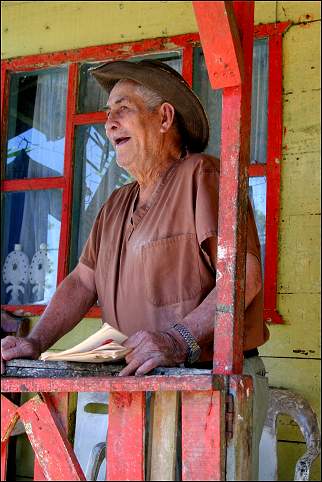 |
Bicycle vacation
Costa Rica
The peaks of the volcanoes hide behind the clouds
Bicycling in a tunnel of green in tropical rainforest where rivers and waterfalls rustle, orchids bloom and monkeys swing screaming from tree to tree. On the Pacific coast it's dry, but even here every now and then the peaks of the volcanoes are hidden by clouds. The Panamerican Highway turns out to be not too busy and better for bicycling than many local roads full of rocks, potholes and bumps. On the peninsula of Nicoya suger cane is harvested; here you can swim with pelicans, while the local population is entertained by a bull rodeo. On the Caribbean coast it's wet. This is Chiquita land.
Travelogue & photos: Gerrie & Aart Dijkzeul
It rains like a warm shower for hours. From drizzling to pouring. On both sides of the road is a wall of plants and flowers, pushing each other out of the way. Countless waterfalls en brooks. So this is a rainforest, a kind of fairy-tale landscape which we cross by bike via the La Fortuna - Tilaran route.
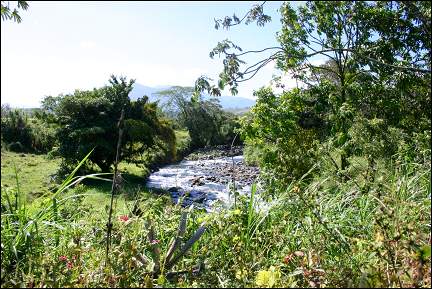 |
Let's start at the beginning. At the end of January we fly from Amsterdam via Miami to San José. From winter in The Netherlands to spring on the Central Plain of Costa Rica.
Costa Rica, one and a half times Holland in size, has a population of 4 million (The Netherlands has 16 million). According to Central-American standards it is relatively wealthy. The country is divided in two halves by a ridge of hills, mountains and volcanoes, of which some are still active. The northeast, the Caribbean part, is hot and humid. All year long. The other side, which faces the Pacific Ocean, has a more varied climate with a dry and a rainy season.
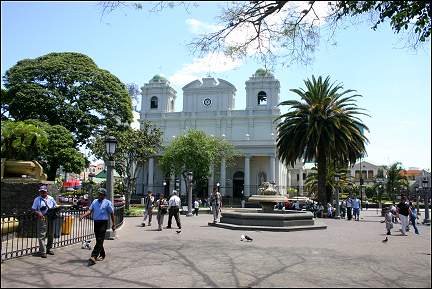 |
San José, the capital of Costa Rica, is where our trip starts. Of course we first go sight seeing in the city. There isn't much to see. A theater, a museum, some parks, pretty streets and that's it, apart from the Ticos (as the Costaricans call themselves).
Green everywhere
Along volcanoes and through rainforest to Liberia
Then the real thing starts: bicycling. The first fifty kilometers we take it easy. We take a bus to St. Clara. The tunnel we need to cross to reach the Caribbean part of the country is off-limits for bicyclists.
On arrival in St. Clara we are welcomed by a mob of blood-thirsty insects who get us back on our bicycles in no time at all. For the next week we look as if we have the pocks.
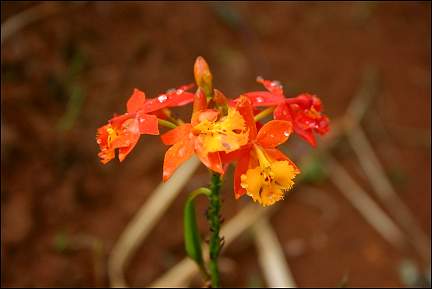 |
After having stayed overnight in San Miguel and Fortuna we cross the mountain ridge again, only farther to the northwest. Via Tilaran and Canas we bicycle on the other side of the mountains north-westward to Liberia. All in all about 300 kilometers.
The route is gorgeous. During the first three days everything is overwhelmingly green. The orchards, the pastures, but especially the rainforest through which we bicycle. Why it is called rainforest we find out when we bicycle from Fortuna to Tilaran. We're not even half an hour on our way when it starts raining. And this continues for the better part of the day.
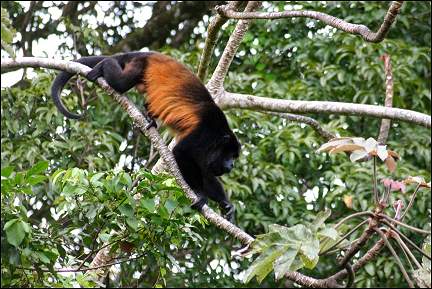 |
But the rain doesn't spoil the fun at all. There is something about bicycling through a green tunnel while the rain keeps falling. Everywhere birds, orchids, lantana's and masses of busy lizzies. Waterfalls and creeks complete the impression of a fairy-tale landscape.
When by the end of the day the rain stops, some loud roaring gives us a scare. It turns out to be a group of monkeys who are doing what they're good at above our heads: swinging from tree to tree. It's fun to see these animals in their natural surroundings.
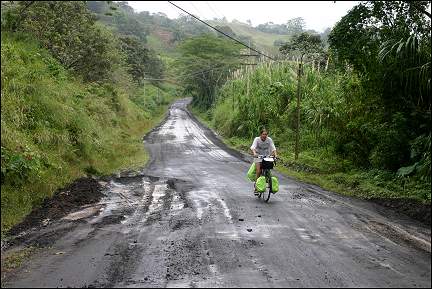 |
The condition of the roads varies. Sometimes they are covered with a perfect layer of asphalt, sometimes they're shitty. Sometimes we're litterally covered in mud. The brakes have a hard time. The hills are often steep. Going up, we can't go faster than 6 kph; going down, our maximum speed is 72 kph.
When the roads are mostly potholes or when it's a gravel road, we have to brake all the time. After only three days we have to replace the brake pads because they're completely worn and when we brake, it's metal on metal. Not great for the rims.
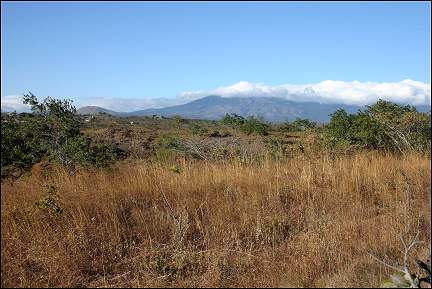 |
Crossing from the Caribbean side to the Pacific side means going from wet to dry. The landscape is completely different. Dry grass; many trees are bare, others are blooming. There is a strong eastern wind. This appears to be normal in February.
The route from Canas to Liberia takes us to the Panamerican Highway, a road which crosses all of Central America (actually: all of North, Central and South America). Our route description discourages bicycling on this highway.
Stubborn as we are, we try. We get up very early, eat our daily breakfast of rice and beans, say a quick prayer and get on the road.
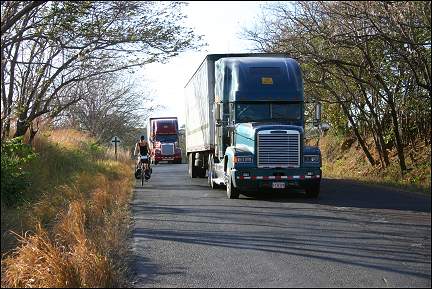 |
It isn't that bad at all. In this part of Costa Rica the Panamerican is a two-lane road with little traffic. Every now and then a bus or an articulated truck of the kind of which every schoolboy dreams (with the big square front and much chrome). Some stretches virtually don't have any traffic at all.
The road surface is not perfect, but good enought that we can enjoy the landscape. Piece of cake.
National Park Rincón de la Vieja
25 kilometers over stones, rocks, potholes and bumps
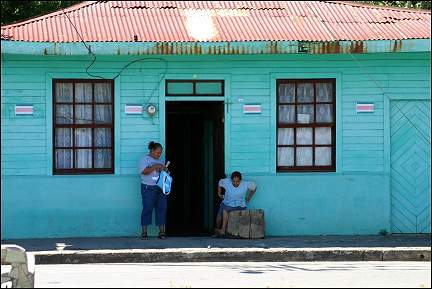 |
Liberia is different from the country with the same name in West Africa in every way. It's a cozy town with - just like every other town we visit - a park with parading Ticos and a relatively new church. Today it is filled to the rim because of the holiday of Candlemas (Feast of the Purification of the Virgin). We are not the only ones who are lighting a candle.
From our first day in Costa Rica we have views of volcanoes. Especially the impressive Arenal, the most active volcano, is visible from a great distance. Except for the peak, which is the most important part; it is covered by a blanket of clouds. Very smart, because this makes us curious enough to want to see it from close by.
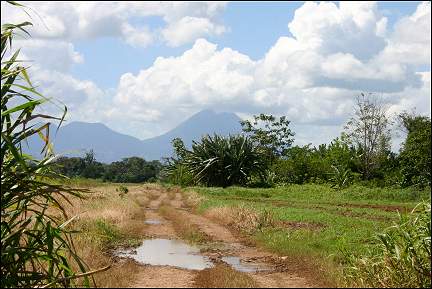 |
We could have done that when we were in Fortuna, except that on that day there were so many clouds that only the foot of the volcano was visible. It was overcast and rainy. Not ideal to visit a volcano. So we decided to forfeit. We knew there would be other opportunities.
Now that we are in Liberia we have the opportunity. This town lies at the foot of the National Park Rincón de la Vieja with the volcano of the same name in it. We still have to bicycle 25 km to get there.
The guy at the Tourist Information office advises us against going there by bicycle. The road is bad and at this time of the year there's a strong wind. We are not dissuaded. With our experience in Laos and Cambodia we should be able to do it, we think. We have to see a volcano from close by, whatever it takes. It turns out the guy was right.
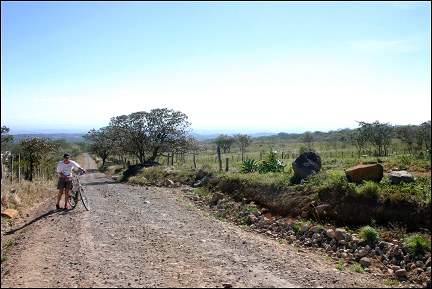 |
The weather is fine, the road is indescribably bad: stones, rocks, potholes and bumps for 25 kilometers. At the same time we also ascend from 250 meters to 1500 meters. Half-way we look at each other: should we turn and go back? No, we don't!
After 18 kilometers we run into a closed fence. The owner of the land behind it charges 1500 colonnes (about 3 Euro) toll to pass. It's not clear what he uses the money for, but definitely not for road repairs.
Four kilometers before the end of the road a sandstorm hits us. Bicycling is impossible. Going back isn't an option either, because then all this suffering would have been in vain. So we plow on against the sand and the wind. Some tourists pass us by in their 4WD and wave. Or do they point at their foreheads?
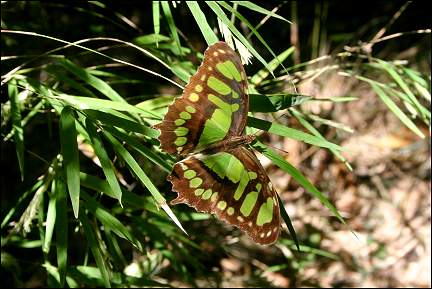 |
After four hours we reach the entrance of the National Park. The lady at the box office calls us brave. That makes up for a lot. But she immediately shatters our joy when she tells us that we can't visit the crater today: it's too late already.
We'll have to limit ourselves to a marked route in the park. Fortunately this makes up for everything. This is what paradise must have looked like: giant trees, flowers, butterflies, monkeys, fast flowing creeks and a tens of meters high waterfall. We even spot an anteater.
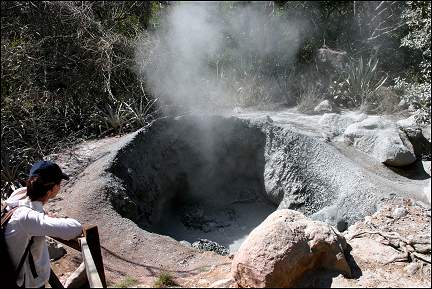 |
The sulphur stench already tells us at a distance that we're approaching Fumaroles. There are holes in the ground from which steam and H2S rise. We see craters with boiling mud and other excretions from the bowels of the earth.
When we leave the park after two hours we are completely recharged for the way back. Two hours of avoiding rocks and squeezing brakes follow. Just before dark we're back in Liberia with sore butts and muscle ache in calves and arms. The bikes apparently didn't suffer any damage. Everything still works.
Bull rodeo on Nicoya peninsula
Village festival with a carnival, a fair, music and bulls
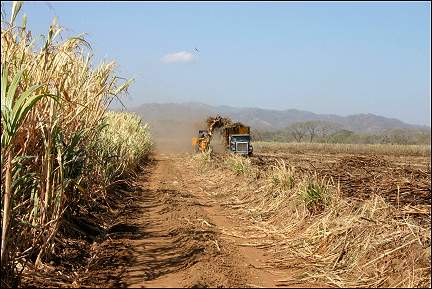 |
Next morning we leave early. This week we visit the northwestern part of the country, the Nicoya peninsula. From Liberia we bicycle in western direction to the Pacific.
Via the provincial capital Nicoya and the towns of Esparza and Atenas we arrive in Cartago; a town 20 km east of San José.
In Nicoya this is the dry season. Strong winds, high temperatures and sun all day long. Fields with sugar cane and vast plains with trees and dry grass where cows graze, cover most of the peninsula. Here and there are hills, up to 500 meters high, and small villages. The occasional farmer on horseback who is driving his cows, makes us feel as if we're in the Wild West.
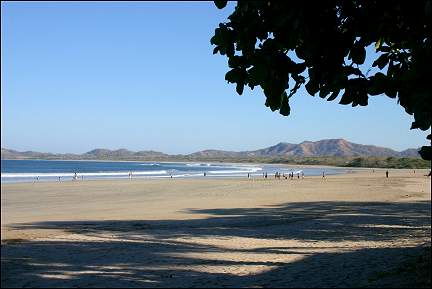 |
Tamarindo is quite different. This town on the Pacific is a surfers Mecca. It's your standard beach resort, which is the same everywhere, whether you're in Thailand, Holland or Costa Rica.
Its six original houses are dwarfed by hundreds of hotels, cabina's, hostels or whatever they're called. The dusty roads are still there.
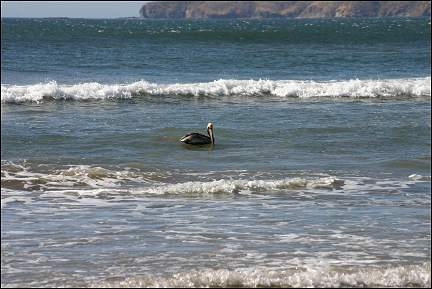 |
Many young and beautiful surfers; we stand out like sore thumbs with our grey hair. It doesn't matter, it's just wonderful to be a beach tourist for a day and to swim in the Pacific between brown pelicans and read a little.
After one and a half day in Tamarindo we leave early, because it's already warm in the morning. It's fun to eat and drink again in a soda (small diner) along the road or in a café in a village or town. We can hardly make ourselves understood, but that has its charms. Especially when the concerned café owner advises us to take our bikes inside with us. You never know who's going to ride away on them.
Some roads are covered with gravel or consist mainly of potholes with a little asphalt around them, but most road are really good. In this part of the country the monkeys roar also to let us know they're up in the trees. It's always fun to watch them. We see lots of beautiful birds, and iguanas up to a meter long.
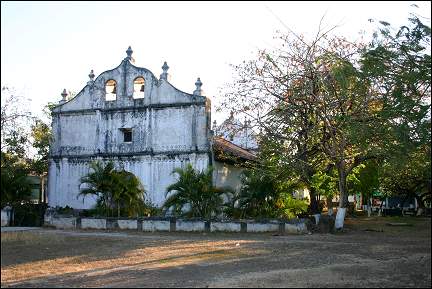 |
Nicoya is a typical Central-American town with a church in the center and a park where people parade or just sit on benches. When we join them in the afternoon, we notice that everyone is walking in the same direction. Curious as we are, we follow them.
The parade takes us to a large field where a kind of village festival is going on. There is a carnival, a fair, music and a pen with bulls. There is a make-shift arena with hastily put-together stands. A girl explains that there will be a bull fight at 5 PM. We pay a 2500 colonnes entrance fee.
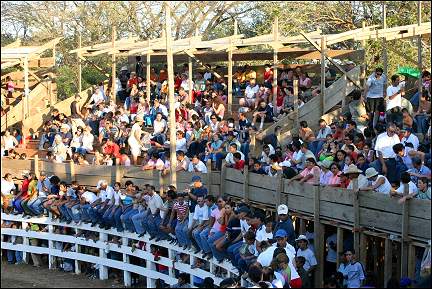 |
It's only 4:30 PM, but it's not so bad to wait half an hour: watching people is fun. Half an hour becomes one and a half hours. The stands in the meantime have filled up to the brim, we estimate that there are 2000 people in the audience.
Before the master of ceremonies has introduced the event and the fifteen toreadores, matadores and bandarillos, the sun has almost set.
The youngsters in the arena are not leaving. Still, at exactly 6 PM the first bull with a toreador on it's back is released. It turns out this is not a real bull fight, but a combination of rodeo and a cat-and-mouse game between the bull and the hundreds of youngsters who are in the arena. The bull moves and jumps wildly, while the rider tries to stay on its back for as long as possible. Usually that isn't more than 30 seconds, after which the toreador leaves the arena, applauded by the audience.
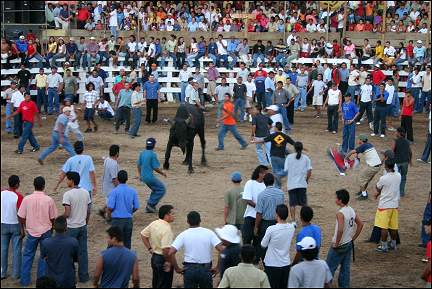 |
Then the boys taunt the bull by walking in front of it, or pulling its tail. When the bull gets near them, they jump out of the way or climb in the fence around the arena. Outside, two ambulances are ready.
After a few minutes the badarillos on horseback catch the bull with their lassos and take it back to its pen. After four rounds there still are no dead or wounded, so we leave. The local folks can't get enough of it.
Climbing to the Central Plain
The driver of a 4WD can't stand it any longer
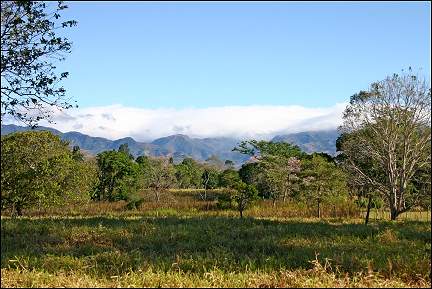 |
After Nicoya we're back to serious climbing and descending. In combination with the sun and high temperatures this causes many a drop of sweat. Beautiful views and generally quiet roads make for much enjoyment.
From Esparza it gets really hard. We climb again to the Central Plain on which San José lies. We don't go faster than 6 kph. The alternative, walking with our bikes, is also hard.
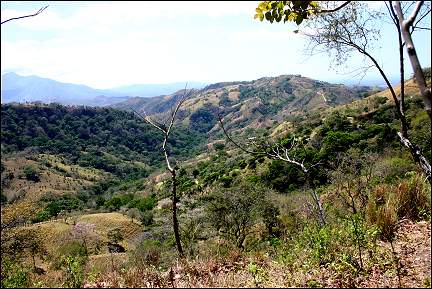 |
Ten kilometers before Atenas a 4WD stops: its driver can't stand to watch us struggle any longer. He offers us a ride, which we accept gratefully. From now on we'll never again slander 4WDs and their drivers.
Now that we've had a taste, we also hitch a ride from Atenas to Cartago. Not so much because of the climbing, but because a large part of the route leads us along the Panamerican Highway, which has much more traffic in this part of the country.
Descending to the Caribbean Coast
All day long we bicycle with our heads in the clouds
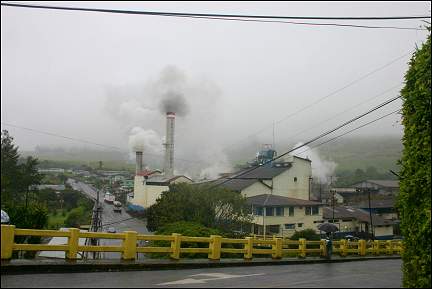 |
We still haven't succeeded in seeing a volcano from close by. When we stick our heads out of the hotel frontdoor this morning, it's grey and there is no wind. Not the right weather to visit the Irazu. So we continue our "coast to coast" tour.
It turns out that it's not only overcast in Cartago. All day long we bicycle with our heads in the clouds. Fog and drizzle. Our view is limited to 50 meters, so we don't see a lot. Jungle, suger cane and hothouses made of screencloth with tropical plants in them. That's pretty much it. Our calves hurt, after all, we're crossing the mountain ridge again.
On arrival in Turialba we're soaked. Not only our rainclothes, but also the protective covers for our bicycle luggage are not doing what they're supposed to. We use the fan in the hotelroom at its fastest setting to dry everything. That works. The weather forecast we consult in an internet café tells us it's going to be rainy in the next few days.
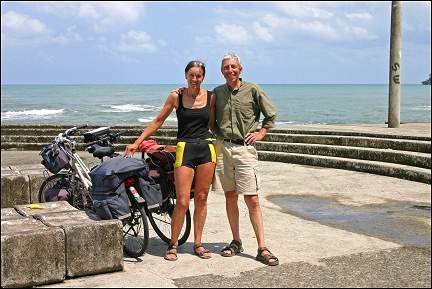 |
So it's a welcome surprise when we wake up next morning with sunlight in our room. It is the first of a couple of beautiful days. Sun, not too steep inclines and a green and varied landscape.
Via Siquirres we reach Puerto Limon on the Caribbean coast. This is where Columbus arrived in the early 16th century, after his fourth crossing of the Atlantic. Not only does the sun rise from the sea here, the whole atmosphere is different. Many people are of Jamaican descent. Not adios, but adios amigo, hand shakes, pleasant chats and a lot of reggae music.
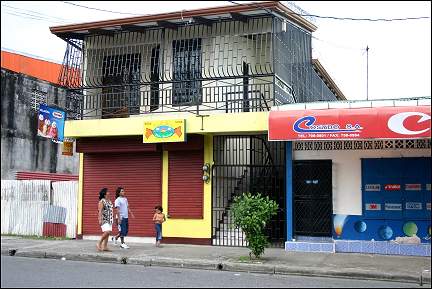 |
It's kind of relaxing. Except that people here, even more than elsewhere in Costa Rica, are paranoid when it comes to crime. Lots of houses in this country are surrounded fences, bars and barbed wire.
Moreover, many people warn us not to leave anything unattended. When we leave our bikes outside (locked), against the advice of a restaurant owner, he ties them with the electrical cord of the microwave.
Along the Caribbean Sea
Chiquita is the overlord here
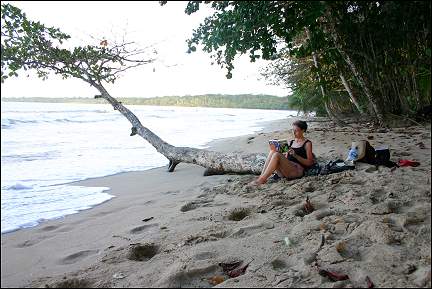 |
Along the coast we bicycle to Cahuita, a beach resort with a few dirt roads with potholes and some hotels and cabinas. We stay for two days. Reading, bird watching (finally we see a hornbill) and of course swimming in the Caribbean Sea. Pura Vista.
Then again on our bicycles, destination Panama. After a few beautiful days, today there is a light rain. Fortunately we have a good view. The landscape is a mix of jungle and peat district. Only instead of potatoes they grow bananas here.
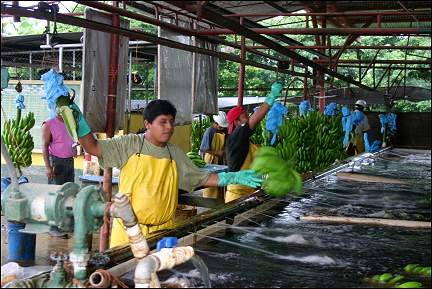 |
Chiquita is lord and master here. We visit a company that prepares bananas from one of the plantations for transport. Like everywhere else in Costa Rica people are very friendly. When we leave, they quickly push a bunch of bananas in our hands for the trip.